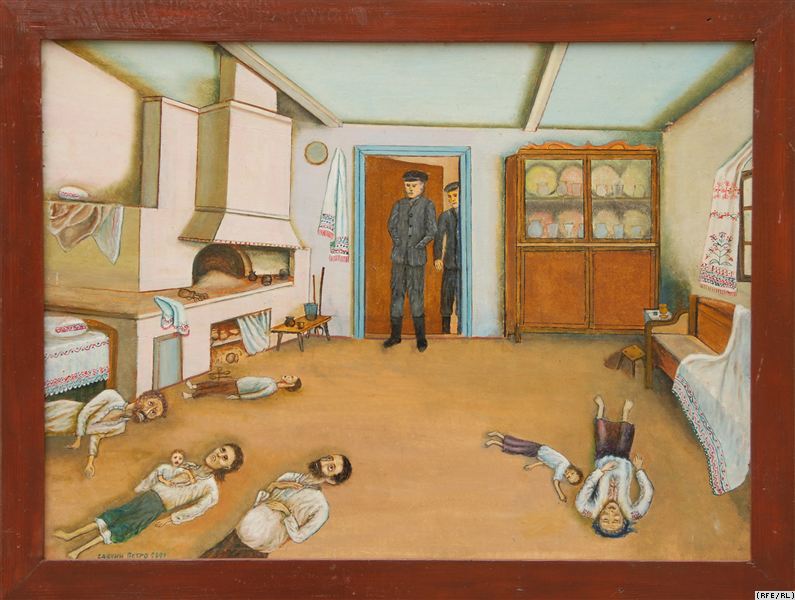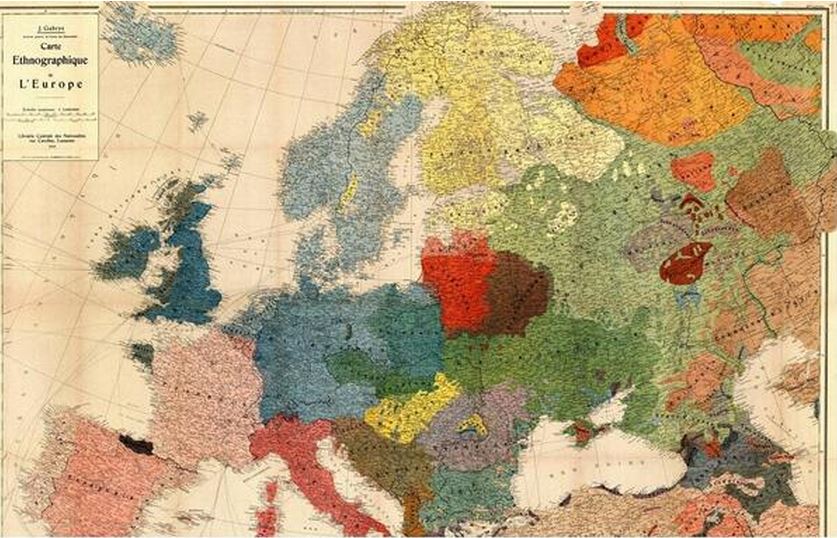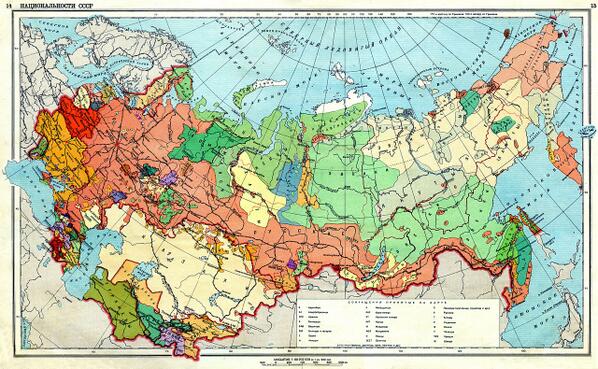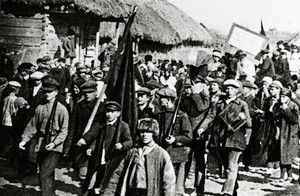Soviet propaganda continues to shape the beliefs of Russians about the Russian and Soviet past and continues to infect public consciousness in the West. The Kremlin’s ongoing denial that Ukrainians were subject to a genocidal famine in 1932-33 under Stalin is a clear example. Russian historiography on the subject contorts the truth to promote the goals of the state, fueled by the legacy of the USSR and its state-decreed “truth.” Unlike post WWII Germany which went through a de-nazification program, Russia has not gone through a de-Sovietization process since the collapse of the USSR.
In fact, under Russian President Putin, who began his career in the murky world of the soviet KGB, Russian historians continue to recycle and reinforce Soviet-era myths.
Denial tactics: deny there was any famine at all
Initially the Soviet approach to the Holodomor was to deny that there was any famine at all, sometimes modified to minimize the extent of the starvation: "Well, there is no famine." Maxim Litvinov, the then Soviet foreign minister told Welsh investigative journalist Gareth Jones. "You must take a longer view. The present hunger is temporary. In writing books you must have a longer view. It would be difficult to describe it as a famine." One of the most notorious peddlers of disinformation was Walter Duranty, Moscow Bureau Chief of The New York Times. He served his own interests in writing to fit the Soviet line. "Russians hungry but not Starving ... Larger cities have food ... Russians and foreign observers in country see no ground for predictions for disaster," Duranty wrote on March 31, 1933.
The New York Times in 1933 denied the artificial famine in Ukraine #Holodomor. pic.twitter.com/griWsi3jCg
— Ruthen (@RutheniaRus) November 22, 2014
Privately he admitted the scope of the famine [1] but his articles loaded with Kremlin propaganda did incalculable damage, obscuring the truth about Ukraine. At the same time he vilified and slandered those such as Gareth Jones who reported the facts on the ground [2]. A great deal of ignorance about the Holodomor persists to this day in the West, largely a consequence of Kremlin sponsored disinformation.
Distinguished scholars including Andrea Graziosi, Norman Naimark, Timothy Snyder, Nicolas Werth and Liudmyla Hrynevych have established beyond any doubt that the Holodomor was indeed genocidal. Raphael Lemkin, the Polish Jewish lawyer, who is credited with “creating” the word “genocide” defines the Ukrainian famine as a genocide:
“This is not simply a case of mass murder. It is a case of genocide, of destruction, not of individuals only, but of a culture and a nation. If it were possible to do this even without suffering we would still be driven to condemn it, for the family of minds, the unity of ideas, of language and of customs that form what we call a nation that constitutes one of the most important of all our means of civilization and progress.”-Raphael Lemkin
A forthcoming book on the Holodomor by Pulitzer-prize winner Anne Applebaum will no doubt provide more details about Duranty and the Soviet cover-up of the Holodomor.
One of the last noteworthy gasps of denial before the collapse of the USSR came in 1987 with the appearance of the book "Fraud, Famine, and Fascism: the Ukrainian Genocide Myth from Hitler to Harvard," endorsed by Communist parties and dismissed by practically everyone else. Its nominal author, Douglas Tottle, admits on page one that the book "does not attempt to study the famine in any detailed way." Instead it presents a conspiracy theory that the Holodomor was cooked up by American fascists for the purposes of "red baiting." The book "appeared in December 1987, practically at the same time that Ukrainian Communist party leader Volodymyr Shcherbytskyi publicly acknowledged the Famine. As a result the book was subsequently withdrawn from circulation." Canadian scholar Roman Serbyn produced a takedown of the book, revealing the extent of Tottle’s distortions and fact twisting.
Denial tactics: minimize extent of Holodomor
With the collapse of the Soviet Union came the opening of the archives. Access to documents made it impossible to deny that millions of people in Ukraine starved to death. Consequently, the Kremlin minimizes the Holodomor to the extent possible, claiming that in the USSR in the early 1930s Ukraine was not special and everyone suffered. Kremlin historian par excellence Prof. Viktor Kondrashin has this to say:
"The documents regarding the history of collectivization studied by specialists and widely introduced into scholarly practice in the nineties and the beginning of 2000s do not confirm the concept of “Holodomor as genocide [...] It is not possible to prove documentarily that the policy of Stalin and his circle in 1932-1933 was aimed at destroying the people of Ukraine or any of its parts. Numerous documentary and other sources on this subject do not have a single direct confirmation of this point which, as we see it, makes the claim on “genocide” itself seem absurd." [3]

Anybody that has taken the time to study the full body of documentation at hand will know that this is simply not true, for there are a number of documents and citations from Stalin and his acolytes that say otherwise:
"Famine in Ukraine was brought on to decrease the number of Ukrainians, replace the dead with people from other parts of the USSR and thereby to kill the slightest thought of any Ukrainian independence."
These are the words of a local communist leader in Kharkiv.
As reported by a Soviet secret police informant, a colleague of the Ukrainian historian and political leader Mykhailo Hrushevskyi sent a message to him stating that what the Communists were doing in Ukraine
"should be explained as a policy targeted at irrevocably breaking down the Ukrainian nation as the only national force able to show serious resistance"
(as revealed in a letter from the Secret Political Department of State Political Directorate of the Ukrainian SSR to Georgy Molchanov, the Head of the Secret Political Department of Joint State Political Directorate, September 10, 1932):
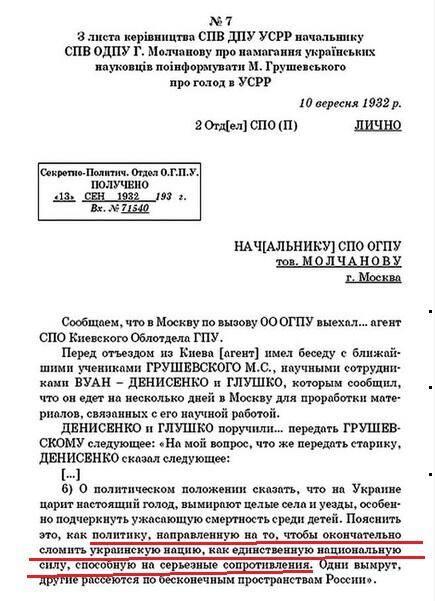
These are just two of the most explicit admissions as to what Stalin’s regime was really doing in Ukraine, but there are other documents which show that Stalin’s policies with regards to Ukraine were quite intentional. For example, on January 1, 1933 Stalin sent a threatening telegram to Kharkiv demanding grain when there was hardly any left and in the process damning the Ukrainian populace regardless of what they have done or could do in the face of continuing starvation. The locals could either hand over all their grain to the state and “not be afraid of reprisal” except this was a recipe for starvation or if they dared to keep their grain they would “be punished in the most severe ways ...”
Documents that point to the genocidal intent of the Holodomor like the ones quoted above are ignored by Kondrashin, who writes:
"The interrelation of industrialization and famine is obvious as is it connected with starvation export. At that, this feature of Soviet industrialization was not been invented by Stalinists. For instance, about 10M Tons of grain was exported from Russia over the period of 1887-1891 to obtain the funds for industrialization, which resulted in the “Tsar-Famine” of 1891-1892. Nearly 13M Tons of grain were exported from Russia in 1930-1933, which caused a severe tragedy in grain producing regions [4]."
The comparison of the Holodomor to famines from the Tsarist era is a common theme amongst Holodomor deniers and Stalin apologetics. An estimated 400,000 died during the famine of 1891-1892. Arguably it helped radicalize the left opposition to the Tsar since the Tsar was completely ineffective in bringing any sort of relief to the afflicted areas. The Holodomor is a completely different story, where famine was used by the state to suppress a people. Kondrashin cites statistics about the excessive export of grain during the two famines. The factual omissions are telling in and of themselves. What's missing is any deeper analysis to the causes of the comparative famines, or how much grain came directly from the famine-affected areas, and why. With regards to the famine areas of 1891-2, the explanation is natural. The Autumn of 1891 was exceptionally dry which had delayed seed planting. What followed was an exceptionally cold but dry winter which left the seeds of what crops there were exposed to deadly frost. The dry conditions continued into the Spring of 1892 ensuring a very limited growth of crops. "That the government's fiscal callousness" as a cause for the famine "is a less likely explanation than the freak weather conditions and backward modes of agriculture." [5] The grain that Ukraine produced in 1932 on the other hand would have been enough to feed Ukraine had it stayed there.
Kondrashin continues: "The theory of “genocide by Holodomor” is not convincing if we consider the actions of Stalin’s regime immediately before and during the Holodomor. If it had been genocide, the regime would have acted similarly to Nazis in “Jewish ghettos” in the time of World War II, i.e cutting provisions and other material resources supplies to Ukraine. This, however, this did not happen." [6]
Except that it did indeed happen. Thousands of Ukrainian villages were blacklisted by the authorities (and some communities were selected for blacklisting from as far away as Moscow [7]) which meant that they were forbidden from trading and were denied deliveries of food and other basics. The borders of Ukraine were closed, and by January 1933 the whole of the Ukrainian SSR was hemmed in. Ukrainians caught crossing into the Russian countryside to find food were sent back to starve. Some 190,000 Ukrainians had been sent back to near certain death by February 1933. [8]

On August 11 1932, Stalin wrote to Kaganovich urging him to "turn Ukraine as soon as possible into a real fortress of the USSR, an exemplary republic." By early 1933, it was clear that the use of the word "fortress" here was not devoid of meaning [9] although Russian historians continue to deny this [10]. Kondrashin states:
"According to our calculations based on the analysis of sources published in the third volume of the collection of documents “Tragedia sovetskoi derevni: collectivizatsiya i raskulachivanie” [“The tragedy of the Soviet countryside: collectivization and dispossession of kulaks”], Ukraine was granted a total of 501,000 tons of grain in 1933, which was 7,5 times more than in 1932 (65,6 thousand tons). Russian regions (excluding Kazakhstan) received 990 thousand tons, which was only 1,5 tons more year-on-year." [11]
He neglects to mention that by the time Ukraine received any sort of grain aid in 1933, the damage was already done and the mission practically complete. Kazakhstan suffered its own genocidal famine as well.
Kondrashin: "Even though Ukrainian historians claim there were unique reasons for famine in every region, according to documents, the famine onset mechanism was common everywhere. It was due to collectivization, peasant resistance in 1932, “punishing peasants with famine” to strengthen the regime and enforce the kolkhoz system. No other mechanism can be traced from the documents. [...] I shall not deny the fact that the famine of 1932-1933 and overall economic crisis in Ukraine gave cause to Stalin’s regime to take preventative measures against the Ukrainian national movement and, in the future, against its potential social base (intelligentsia, state government members, peasantry) when a conflict of USSR with its enemies ripened and burst out. [13]."
“[P]unishing peasants with famine ... preventative measures against the Ukrainian national movement… ” And there you have it, buried in all his rhetoric, a description of the Holodomor that corresponds to the legal definition of genocide as set out by the UN in Article II of Resolution 260 (III) A via the 1948 Convention on the Prevention and Punishment of Genocide:
In the present Convention, genocide means any of the following acts committed with intent to destroy, in whole or in part, a national, ethnical, racial or religious group, as such:
(a) Killing members of the group;
(b) Causing serious bodily or mental harm to members of the group;
(c) Deliberately inflicting on the group conditions of life calculated to bring about its physical destruction in whole or in part;
(d) Imposing measures intended to prevent births within the group;
(e) Forcibly transferring children of the group to another group.”
In the aforementioned telegram Stalin sent to Kaganovich on August 11 1932, Stalin accused the Ukrainian people and even Ukrainian communists of being full of “rotten elements … the agents of Pilsudski.” By December 1932, he had expanded his accusations that the Ukrainian people and even local Ukrainian Communists were engaging in “sabotage” of his grain procurement plans. This line of reasoning was but a pretext, an excuse to engage in a series of measures wholly disproportionate to whatever alleged real or imaginary “crimes” any Ukrainian might have committed. Moreover, as Kondrashin admitted, they were targeted against the Ukrainian national movement and peoples. By 1933, countless thousands of Ukrainian intellectuals and priests were either dead or imprisoned in Siberian gulags. In 1932-33, Stalin began a process that by 1939 saw 98% of Ukraine’s communist leadership being liquidated. In a document titled “Decree of the government of the USSR condemning Ukrainization for difficulties in Grain Procurement” which came from Moscow on December 14 1932, all the above was spelled out quite clearly:
“The CC AUCP(b) and SNK USSR order the CC CP(b)U, North Caucasus regional Party & executive committees & the RNK of Ukraine" to "root out these counterrevolutionary elements by means of arrest and long-term imprisonment in concentration camps, without stopping short of capital punishment for the most malicious elements …. [For Communist party members, we recommend] 5 to 10 year terms of imprisonment in concentration camps and, under certain circumstances, execution by shooting.”
“Ukrainization”, the policy that had allowed the Bolsheviks to consolidate their power in Ukraine and in majority ethnic Ukrainian areas in the Kuban area (in the North Caucasus) by appealing to the national sentiments of the people, and which had temporarily resulted in a renaissance of Ukrainian national consciousness was now deemed "irresponsible" and for being "at variance with the cultural interests of the population." The solution was radical; populate these lands "with conscientious collective farmers who have served in the Red Army and are now working in other territories that suffer from the shortage & poor quality of land. Transfer to these settlers all the lands, winter crops, buildings, equipment, & cattle" of "farmers being expelled." So, dead & condemned Ukrainians were going to be replaced by loyal Red army ex-servicemen from elsewhere in the USSR. Policy words from Moscow that confirm what the aforementioned communist leader from Kharkiv said about the intent behind the Holodomor. And the famine, as Kondrashin admits was deliberately used to inflict conditions of life calculated to bring about the physical destruction of the Ukrainian populace and spirit. And that is the definition of genocide.

But Kondrashin continues:
"We believe that the famine of 1932-1933 caused the death of 4 to 5 million or even more people outside Ukraine. This issue is currently under thorough investigation by Russian specialists. Can we say that those people were victims of the “genocide by Holodomor”? [12].
The interesting thing about this point is that ethnographic maps, including ones produced by the Soviet state as late as 1941, depict ethnic Ukrainian lands extending beyond the borders of the Ukrainian SSR.
Reputable scholars agree that as many as 4 to 5 million Ukrainians died in Ukraine between 1932-33. How many more Ukrainians died in the majority ethnic Ukrainian areas outside the Ukrainian SSR may be harder to quantify, but if it is one to two million, the total is five to seven million Ukrainians dead as a result of the Holodomor [14]. In Kazakhstan, Stalin's repression was intertwined with national oppression of a nomadic culture. While territorially larger than Ukraine, Kazakhstan is largely desert or semi-desert and more sparsely populated, however, it’s losses were far more proportionally devastating than practically any Russian area in the RSFSR which fell under the wrath of Stalin’s eyes. According to Sergei Maksudov, the total number of Kazakh deaths related to Stalin's policies in Kazakhstan amounted to 1.45 Million, or approximately 34% of Ethnic Kazakhs at the time. [15] Stalin was never in any sort of mood to treat the Kazakh peoples fairly. In an encrypted telegram he sent to the Communist leadership of Kazakhstan on November 21 1932, he would accuse the Kazakh peoples, including even local Kazakh communists of “sabotage” and in the process, use the same set of lies that he used as a pretext to crush Ukraine. "It must be understood that under such conditions,” Stalin wrote “the Soviet of People’s Commissars and the regional [Communist] party committee could not take any path but that of repressions although, obviously, repressions alone will not suffice and parallel to repressions we need a wide and systematic propaganda campaign.” What that meant was that famine in Kazakhstan would be entwined with the state sanctioned persecution of Kazakh tribal and religious authorities, just as the intellectual elite were targeted for repression in Ukraine.
While it is true that the USSR starved Russian citizens as well, this fact does not explain the disproportionate amount of suffering in both Ukraine and Kazakhstan. Holodomor specialist James Mace noted that, at an international conference on the Holodomor in 2003, Kondrashin and his Russian colleagues seemed to concede this point; "[O]ur Russian colleagues admitted that certain specific things happened in Ukraine and the then mainly Ukrainian Kuban, which perhaps led them to abstain on the final conference resolution." [16] It seems then that while Kondrashin knows the truth, doesn't want to face the consequences of it. In this light, Kondrashin's conclusions seem banal:
"In conclusion, I would like to inform the respected Ukrainian readers once more of the approach to studying the USSR famine of 1932-1933 adopted by Russian and foreign scholars who do not adhere to the concept of “genocide by Holodomor” in Ukraine.
- The famine was caused by the anti-peasant policy of the Stalin regime during the first five-year plan, its miscalculations and hellish measures with respect to peasantry, which resulted in the collapse of agriculture and led to the famine.
- The famine was not planned in advance. However, it was used by the Stalin regime to force peasants to work in kolkhozes and consolidate around chosen political course.
- The famine was different between regions, which determined its magnitude and consequences. Primarily, it was most severe in areas of total collectivization, where the authorities faced an active resistance from the peasantry and a threat of a total collapse of the agricultural sector.
- The famine did not ‘choose’ to strike anyone in particular. There was no such a thing as genocide of a Ukrainian people specifically, but a common tragedy of Ukrainians, Russians and other peoples of our country through the fault of USSR leaders of the time. The famine of 1932-1933 – is a tragedy of the Soviet countryside, including that of Russia and Ukraine” [17].
I've quoted Kondrashin's conclusions, confident in the reader’s ability to decide who has the better argument here. Leon Trotsky, a man with his own taste for revolutionary violence, commented in 1939,
"Nowhere did restrictions, purges, repressions and in general all forms of bureaucratic hooliganism assume such a murderous sweep as they did in Ukraine in the struggle against the powerful, deeply-rooted longings of the Ukrainian masses for greater freedom and independence [18]."
What Trotsky termed "bureaucratic hooliganism" constitutes genocide, and no amount of rhetorical gymnastics on the part of Russian state historiography can make it otherwise. It is reprehensible that Holodomor denial is still the position of Russian historians in service of the Kremlin. This nasty legacy of the USSR must be dealt with.
[hr][1] R Conquest, "Reflections on the ravaged century," p.133
[2] For more details see S.J. Taylor, "Stalin's Apologist: Walter Duranty: The New York Times's Man in Moscow"
[3] V Kondrashin - О самом главном: Профессор Станислав Кульчицкий и его российский коллега Виктор Кондрашин: чем был Голодомор 1932–1933 годов? // День. 3 июня 2008. См. также последнюю монографию профессора Кондрашина: Кондрашин В.В. Голод 1932–1933 годов: Трагедия российской деревни. М., 200
[4] Kondrashin, ibid.
[5] R Service, "Lenin: A biography", p86-7. Most Russian radicals, Service notes "did not give the government the benefit of the doubt. They saw the famine as a ghastly indication of the regime's ineptitude and brutality; they argued too, that the whole country had been brought into disrepute across Europe." Many said radicals did engage in voluntary famine relief bodies but not Lenin. "His heart had been hardened" He wouldn't even condone the formation of famine relief bodies to use them to spread revolutionary propaganda.
[6] Kondrashin, Op Cit.
[7] T.Snyder, "Bloodlands: Europe between Hitler and Stalin," p.43.
[8] T.Snyder, Ibid, p45.
[9] T Snyder, Ibid, p45.
[10] See A Dyukov, "The Soviet Story: The Mechanism of lies", p43. "This document" he says "has been repeatedly published both by Russian and Ukrainian historians and does not contain a single word about the need to commit genocide of Ukrainians." but he does not mention any studies detailing the publishing of this document.
[11] Kondrashin, Op cit.
[12] Kondrashin, ibid.
[13] Kondrashin, ibid.
[14] Which would line up with the figs provided in R Conquest, "The Harvest of Sorrow", p303. "Subtracting about 500,000 for the Ukrainian dead of the dekulakization of 1932, we are left with Six million [Ukrainians] dead in the famine. This would be divided into 5 million in the Ukraine and 1 million in the North Caucasus..." It's also worth noting Conquest estimates a total of 1 million non ukrainian deaths in the relevant areas. Giving a total of 7 million Holodomor deaths.
[15] S Maksudov, ““Migratsii v SSR v 1926-1939 godakh.” Cahiers du monde russe 40, no 4 (1999)”, p770-96.
[16] Interestingly, Mace continues "the book (ed Kondrashin) was published in a series called American Studies of Russia, and carried a great deal of misinformation about the US commission where I once worked, drawn from one Stepan Merle, who decided some years ago to write on why the commission was created without bothering to look up its legislative history, and that of Mark Tauger, whose argument - that the 1932 harvest was so bad that Stalin was forced to starve the peasants in order to feed the cities - is not taken seriously by either Russians or Ukrainians who have studied the topic." Despite seemingly knowing the truth, Kondrashin remains as dishonest as ever.
[17] Kondrashin, Op Cit.
[18] Trotsky, "Problem of the Ukraine"

